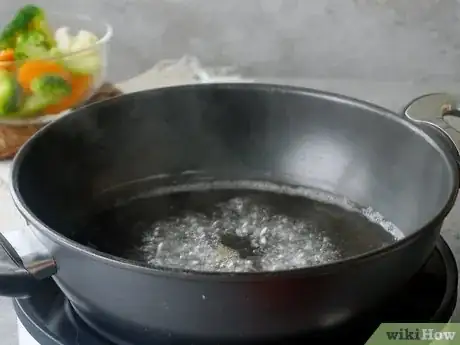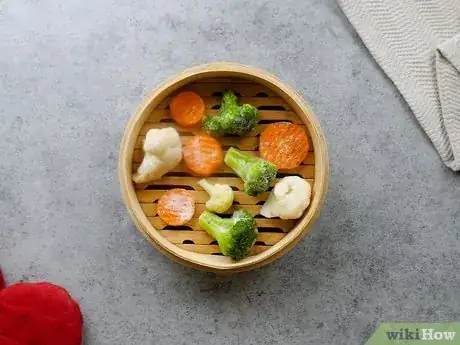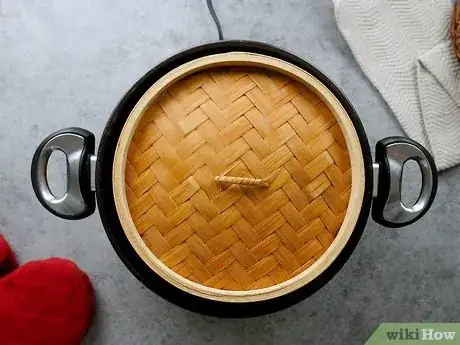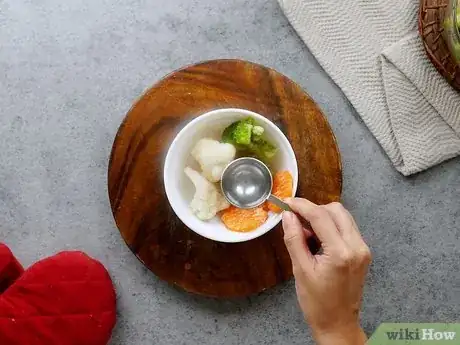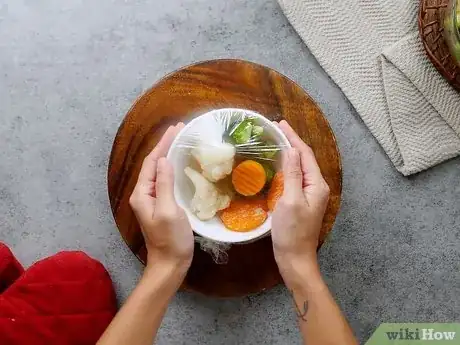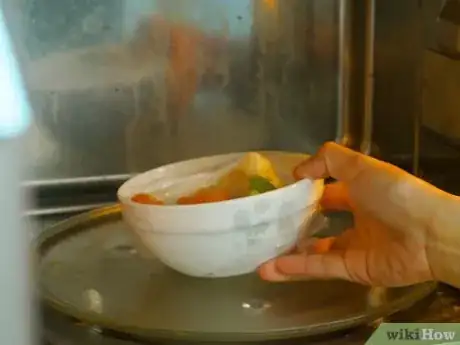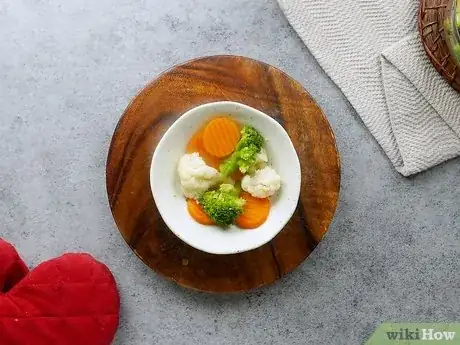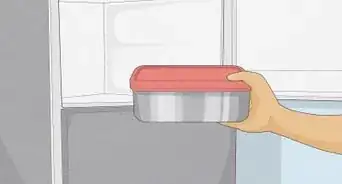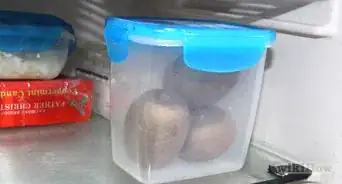This article was co-authored by Jerran Boyer and by wikiHow staff writer, Hunter Rising. Chef Jerran Boyer is a Nutrition-Focused Professional Chef and the CEO of Health Nut Chefs. Chef Jerran has over 20 years of experience as a private chef. She and her team specialize in providing healthy, fresh-prepared meals designed with each client’s taste and dietary needs in mind. She and her team offer both personal, part-time chef services and private, full-time chef services in New York, New Jersey, and the Los Angeles area. Chef Jerran received her BS in Business Administration from the University of South Florida, a degree in Culinary Arts from Florida Culinary Institute, and a Plant-Based Nutrition Certificate through Cornell University.
There are 14 references cited in this article, which can be found at the bottom of the page.
This article has been viewed 69,308 times.
If you’re looking for a way to make frozen vegetables just as tasty as if they were fresh, steaming your veggies is perfect for preserving their flavors and texture. Since they’re frozen at their peak freshness, your frozen vegetables will still have all their nutrients after you steam them. Keep reading to learn how to use your stove or microwave to steam frozen vegetables, plus how long you should cook them!
Things You Should Know
- To steam on the stove, boil a pot of water. Put a steamer basket or colander in the pot and add your veggies. Cook them for 5–15 minutes, or until they’re warm.
- To steam in the microwave, put your vegetables in a bowl and add water to cover the bottom. Cook the veggies for 3–5 minutes, or until they feel tender.
- Steam most vegetables straight from frozen. Thaw any vegetables that have a high moisture content, like spinach, before you cook them.
Steps
Stovetop
-
1Boil 1 in (2.5 cm) of water in a pot. Fill the bottom of your pot with water and set it on your stove over high heat. Bring the water to a rolling boil so the pot is steaming.[1]
- Avoid filling up your pot any higher since your vegetables could get a mushy texture if they sit in the water.
-
2Put the veggies in a colander or steamer basket in the pot. Pour your frozen vegetables into your colander or steamer basket and spread them out evenly. Set the colander or steamer basket inside the pot so it hangs on the lip of the pot. Make sure the water isn’t touching your veggies, or it could draw out their flavors or change their texture.[2]
- You do not need to thaw most frozen vegetables before you cook them.[3] Vegetables that have a higher moisture content, like frozen brussel sprouts, should be thawed so you don’t add extra moisture to a recipe.[4]
- If you need to steam your vegetables without a steamer, then put 3 golf ball-sized balls of aluminum foil in the water. Set a heat-proof plate on the foil and pour your vegetables on it.
Advertisement -
3Cover the pot and steam the vegetables until they’re tender. Put a lid on the pot to trap the steam inside so your vegetables can thaw and cook through. Most frozen vegetables are fully cooked and contain salt, so they can be steamed quickly and without salt. If you’re unsure whether your veggies are fully cooked, stick them with a fork. If they feel tough or hard in the center, then steam them a bit longer.[5]
Microwave
-
1Pour the frozen vegetables into a microwave-safe bowl. You don’t need to thaw most vegetables before you steam them. Just put the veggies into your bowl and spread them out evenly so all the pieces cook through.[11]
- Some frozen vegetables come in a steamer bag that you can put right in your microwave. Check the instructions on the bag of vegetables to see if it’s microwave-safe.[12]
-
2Add 2–3 US tbsp (30–44 ml) of water to the bowl. The water in the bowl helps create steam, as well as keep your vegetables from drying out while they cook. Make sure the water only covers the bottom of the bowl, which should only take about 1⁄4 cup (59 ml) at most. If any of your vegetables are completely submerged, then you have too much water.[13]
- Avoid putting any more water in the bowl since it could make your vegetables soggy.
-
3Cover the bowl with a lid or microwave-safe plastic wrap. The lid or plastic wrap helps trap some of the steam so your vegetables thaw and cook faster. Just leave a small crack or opening on top so the steam can eventually escape. That way, pressure won’t build up inside the bowl.[14]
-
4Microwave your veggies on high for 3–5 minutes. Put your vegetables in your microwave and set it to high power. Steam your vegetables in the microwave for a few minutes so they can thaw and warm up. If your vegetables still aren’t completely thawed or cooked through, then put them back in for 1-minute increments until they feel warm.[15]
- Be careful not to overcook your vegetables since they could turn mushy.
- Larger, firmer vegetables like potatoes, brussel sprouts, and broccoli may take a few minutes longer to cook through since they have thicker pieces. Poke the veggies with a fork and if they still feel tough in the middle, microwave them for another minute.
-
5Drain any excess water before serving your veggies. Since your microwave might not have turned all the water to steam in the bowl, carefully pour out any water that’s still leftover so the vegetables don’t get soggy. Toss the vegetables in your favorite seasonings and serve them while they’re hot.[16]
Expert Q&A
-
QuestionHow do you steam vegetables on the stove without a steamer?
 Jerran BoyerChef Jerran Boyer is a Nutrition-Focused Professional Chef and the CEO of Health Nut Chefs. Chef Jerran has over 20 years of experience as a private chef. She and her team specialize in providing healthy, fresh-prepared meals designed with each client’s taste and dietary needs in mind. She and her team offer both personal, part-time chef services and private, full-time chef services in New York, New Jersey, and the Los Angeles area. Chef Jerran received her BS in Business Administration from the University of South Florida, a degree in Culinary Arts from Florida Culinary Institute, and a Plant-Based Nutrition Certificate through Cornell University.
Jerran BoyerChef Jerran Boyer is a Nutrition-Focused Professional Chef and the CEO of Health Nut Chefs. Chef Jerran has over 20 years of experience as a private chef. She and her team specialize in providing healthy, fresh-prepared meals designed with each client’s taste and dietary needs in mind. She and her team offer both personal, part-time chef services and private, full-time chef services in New York, New Jersey, and the Los Angeles area. Chef Jerran received her BS in Business Administration from the University of South Florida, a degree in Culinary Arts from Florida Culinary Institute, and a Plant-Based Nutrition Certificate through Cornell University.
Nutrition-Focused Professional Chef Place vegetables in a wide, shallow pan (such as a sauté pan) with a little bit of water to cover the bottom—about 1 in (2.5 cm) is good. Steam the vegetables with the lid off until they're just softened; then, drain them in a colander to serve.
Place vegetables in a wide, shallow pan (such as a sauté pan) with a little bit of water to cover the bottom—about 1 in (2.5 cm) is good. Steam the vegetables with the lid off until they're just softened; then, drain them in a colander to serve.
Warnings
- Be careful when you take off the lid since the steam could be extremely hot and cause burns.⧼thumbs_response⧽
- Use butter and oil sparingly when you’re seasoning since they can make your vegetables feel greasy.[20]⧼thumbs_response⧽
Things You’ll Need
Stovetop
- Stove
- Pot
- Steamer basket or colander
Microwave
- Microwave
- Microwave-safe bowl
- Microwave-safe plastic wrap
References
- ↑ https://www.epicurious.com/expert-advice/how-to-steam-vegetables-step-by-step-article
- ↑ https://www.ag.ndsu.edu/publications/food-nutrition/vary-your-veggies-how-to-prepare-vegetables
- ↑ https://www.eatright.org/homefoodsafety/four-steps/refrigerate/thawing
- ↑ https://www.thekitchn.com/frozen-vegetable-mistakes-259663
- ↑ https://www.thekitchn.com/frozen-vegetable-mistakes-259663
- ↑ https://quartermaster.army.mil/JCCoE/publications/recipes/section_q/q_g_006.pdf
- ↑ https://quartermaster.army.mil/JCCoE/publications/recipes/section_q/q_g_006.pdf
- ↑ https://www.dilip.info/vegetableSteamingGuide.pdf
- ↑ http://www.dilip.info/vegetableSteamingGuide.pdf
- ↑ https://quartermaster.army.mil/JCCoE/publications/recipes/section_q/q_g_006.pdf
- ↑ https://10minhomemaking.com/how-to-cook-frozen-vegetables-in-microwave/
- ↑ https://blogs.extension.iastate.edu/answerline/2020/04/23/steaming-vegetables/
- ↑ https://www.bbcgoodfood.com/howto/guide/how-steam-vegetables
- ↑ https://www.foodnetwork.com/healthyeats/healthy-tips/2009/05/healthy-how-to-steaming-veggies
- ↑ https://10minhomemaking.com/how-to-cook-frozen-vegetables-in-microwave/
- ↑ https://10minhomemaking.com/how-to-cook-frozen-vegetables-in-microwave/
- ↑ https://www.thekitchn.com/ignore-this-step-when-cooking-with-frozen-vegetables-tips-from-the-kitchn-215950
- ↑ https://www.thekitchn.com/eight-ways-to-make-steamed-vegetables-taste-amazing-tips-from-the-kitchn-73707
- ↑ https://www.thekitchn.com/frozen-vegetable-mistakes-259663
- ↑ https://10minhomemaking.com/how-to-cook-frozen-vegetables-in-microwave/
About This Article
To steam frozen vegetables on the stovetop, first fill a pot with 1 in (2.5 cm) of water. Bring the water to a boil over high heat. Next, place your frozen vegetables into a colander or steamer basket and spread them out evenly. Set the colander or steamer basket inside the pot so it hangs on the lip of the pot. Make sure that the water isn’t touching your veggies, or it could draw out their flavors and change their texture. Cover the pot and steam the vegetables until they’re tender. If you’re unsure whether your veggies are fully cooked, stick them with a fork. If they feel tough or hard in the center, then steam them a bit longer. To steam frozen vegetables in the microwave, first place your veggies into a microwave-safe bowl. Next, add 2–3 tbsp (30–44 mL) of water to the bowl. Cover the bowl with a lid or microwave-safe plastic wrap then microwave on high for 3–5 minutes. If they still aren’t cooked completely, microwave in 1-minute increments until they feel warm. Drain any excess water before serving and enjoy!
